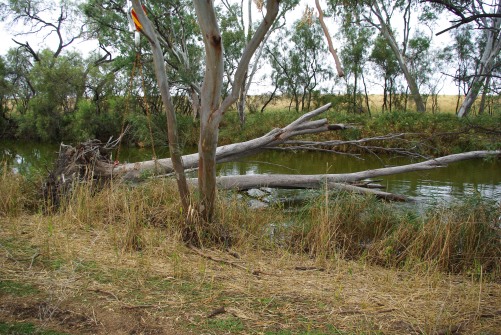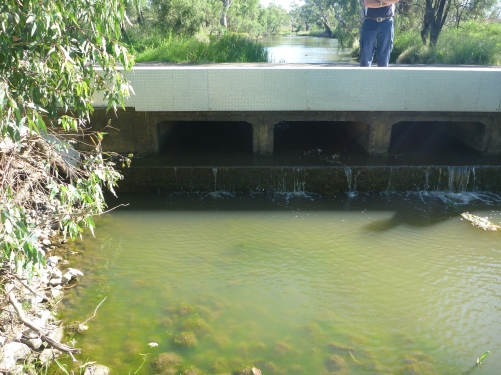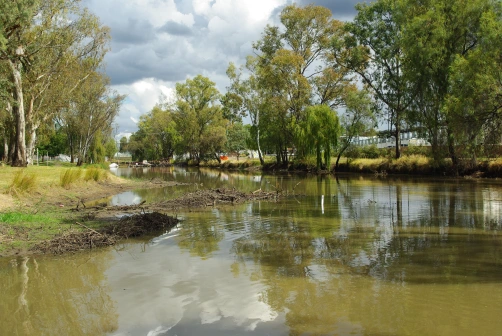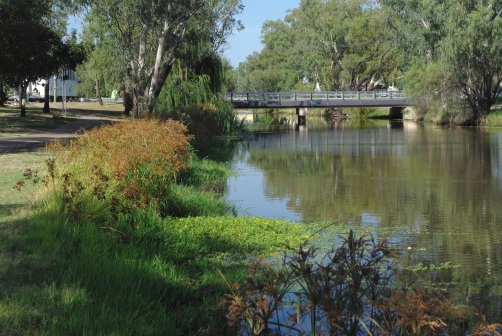Key words: native fish, riparian habitat, fish passage, aquatic habitat, Native Fish Strategy
The Dewfish Demonstration Reach is a 110 kilometre stretch of waterway in the Condamine catchment in southern Queensland consisting of sections of the Condamine River, Myall Creek and Oakey Creek near Dalby. The Reach was established in 2007 with the purpose of promoting the importance of a healthy river system for the native fish population and the greater river catchment and demonstrating how the restoration of riverine habitat and connectivity benefits native biodiversity and local communities. Landholders, community groups, local governments and residents have worked together to learn and apply new practices to improve and protect this part of the river system.
The purpose of the project is to demonstrate how the restoration of riverine habitat and connectivity benefits native biodiversity and promote the importance of a healthy river system for native fish and the greater river catchment. The goal is to restore native fish populations to 60% of pre-European settlement levels and improve aquatic health within the Reach.

Fig 1. Adding structural timber to Oakey Creek

Fig 2. Installing a fish hotel into Oakey Creek
Works undertaken. A range of activities to improve river health and native fish communities have been undertaken primarily at seven key intervention sites within the Dewfish Demonstration Reach. These include:
- Re-introduction of large structural habitat at five sites, involving the installation of 168 habitat structures consisting of trees, fish hotels, breeding pipes and Lunkers (simulated undercut banks).
- Improvement of fish passage (by more than 140 km) with the upgrade of the fishway on Loudoun Weir and the installation of two rock-ramp fishways on crossings in Oakey Creek.
- Ongoing management of pest fish, involving carp angling competitions, carp specific traps, electrofishing and fyke nets.
- Rehabilitation of the riparian vegetation over 77 km of the Reach using stock exclusion fencing, off-stream watering points, weed control and replanting of native vegetation. In Dalby, a 1 metre wide unmown buffer was established on the banks Myall Creek.
Twice-yearly monitoring using a MBARCI model (multiple-before-after-reference-control-intervention) was undertaken to detect the local and reach-wide impacts of the intervention activities. Surveys involved sampling of the fish assemblage at fixed sites and assessment of the instream and riparian habitat.

Fig. 3 Wainui crossing before the fishway

Fig 4. Wainui crossing after the installation of the rock ramp fishway
Results. The surveys indicated many of the intervention activities had a positive impact. The fish assemblage and riparian habitat improved at all intervention sites in the Dewfish Demonstration Reach since rehabilitation activities commenced.
The fish assemblages at introduced habitat structures were very similar to those found on natural woody debris, suggesting the introduced habitat is functioning well as a surrogate.
There were significant increases in the abundance of larger fish species, including Golden Perch (Macquaria ambigua) (up to 5-fold), Murray Cod (Maccullochella peelii peelii) (from absent to captured every survey), Spangled Perch (Leiopotherapon unicolor) (up to 9-fold) and Bony Bream Nematolosa erebi (up to 11-fold) in intervention sites following re-snagging. Murray Cod and Golden Perch are now consistently being caught from introduced woody structures and local anglers are reporting that the fishing has improved greatly. Despite this increase there is still limited evidence of recruitment in the area. There have also been small increases in Eel-tailed Catfish (Tandanus tandanus) and Hyrtls Tandan (Neosilurus hyrtli) abundances and a limited amount of recruitment has been observed for these species.
The abundance of smaller native fish has improved significantly in response to the intervention activities undertaken, especially where bankside and instream vegetation was improved. In Oakey Creek Carp Gudgeon (Hypseleotris spp.) abundance increased 1200-fold, Murray-Darling Rainbowfish (Melanotaenia fluviatilis) increased 60-fold and the introduced species Mosquitofish (Gambusia holbrooki) increased 9-fold following intervention activities.
Establishment of a bankside unmown buffer on Myall Creek has enabled natural regeneration of vegetation and resulted in significant increases in aquatic vegetation and native trees. This has led to substantial increases in the smaller bodied native fish assemblage, including a 3-fold increase in Bony Bream, 237-fold increase in Carp Gudgeon, 60-fold increase in Murray-Darling Rainbowfish and a 35-fold in the introduced Mosquitofish.
The abundance of pest fish remains low, except for Mosquitofish which have increased in abundance with the improvements in the aquatic vegetation. There is little evidence of Carp recruitment (Cyprinus carpio), suggesting active management may continue to suppress the population and minimise this species impacts in the Reach.

Fig 5. Myall Creek prior to restoration

Fig 6. Myall Creek after restoration
Lessons learned and future directions. Improvements of the waterway health and ecosystems can lead to positive responses from native fish populations.
- Targeting rehabilitation activities to specific classes of fish has been very effective.
- Introducing habitat structures has been effective for larger fish, and
- Re-establishing healthy bankside and aquatic vegetation has been vital in boosting the abundance of juveniles and smaller species.
Improvements in the extent of aquatic vegetation have unfortunately also resulted in increased numbers of the introduced pest, Mosquitofish. However, the overall benefits to native fish far outweigh impacts from the increase in the Mosquitofish population.
Stakeholders and Funding bodies. A large number of stakeholders have been involved in this project. The project’s success is largely due to the high number of engaged, involved and committed stakeholders. Without this broad network, costs to individual organizations would be higher and strong community support less likely.
Major funding has been provided by the Murray Darling Basin Authority, Condamine Alliance, Queensland Department of Agriculture and Fisheries and Arrow Energy.
Contact. Dr Andrew Norris, Senior Fisheries Biologist, Queensland Department of Agriculture and Fisheries, Bribie Island Research Centre, PO Box 2066, Woorim, QLD 4507; Tel (+61) 7 3400 2019; and Email: andrew.norris@daf.qld.gov.au
READ MORE:
Finbox demonstration reach toolbox: http://www.finterest.com.au/finbox-a-demonstration-reach-toolbox/
Native Fish Strategy – first 10 years. http://onlinelibrary.wiley.com/enhanced/doi/10.1111/emr.12090
Demonstration reaches – Looking back, moving forward http://onlinelibrary.wiley.com/enhanced/doi/10.1111/emr.12092
Monitoring in demonstration reaches https://site.emrprojectsummaries.org/2014/01/25/establishing-a-framework-for-developing-and-implementing-ecological-monitoring-and-evaluation-of-aquatic-rehabilitation-in-demonstration-reaches/




